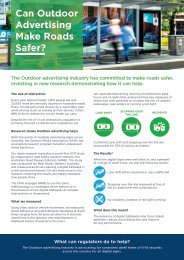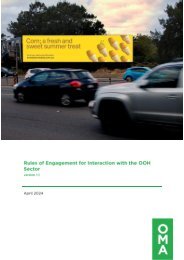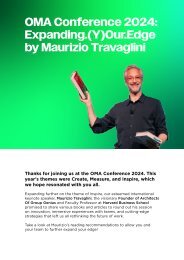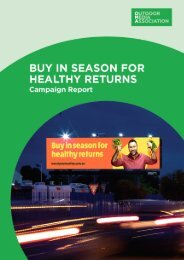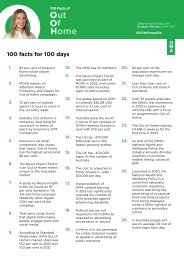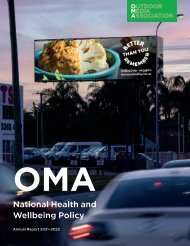OPEN 2
The OPEN series was born from the desire to create a forum for applauding and interrogating strong creative design within the Out of Home (OOH) industry. Illustrating how OOH is part of our cityscape, our commute, our weekend and our shopping and holiday experiences, OOH is ‘the original tweet’ and it cannot be switched off, ignored or fast forwarded. Big, bold, cheeky, simple, clever and controversial, OOH is the ultimate creative stage, allowing brands to be unique, contextually relevant and targeted while reaching mass audiences.
The OPEN series was born from the desire to create a forum for applauding and interrogating strong creative design within the Out of Home (OOH) industry. Illustrating how OOH is part of our cityscape, our commute, our weekend and our shopping and holiday experiences, OOH is ‘the original tweet’ and it cannot be switched off, ignored or fast forwarded. Big, bold, cheeky, simple, clever and controversial, OOH is the ultimate creative stage, allowing brands to be unique, contextually relevant and targeted while reaching mass audiences.
Create successful ePaper yourself
Turn your PDF publications into a flip-book with our unique Google optimized e-Paper software.
SELL ME SOMETHING<br />
Ben Colman, Chief Executive Officer,<br />
18 Feet & Rising<br />
...<br />
There are few purer tests of an advertising<br />
professional’s talent than to create magic<br />
out of a simple product truth. Bill Bernbach<br />
threw down the glove in 1959 when he used<br />
the humble product image of a Volkswagen,<br />
underscored by the one-word headline<br />
‘Lemon’ and word-perfect copy, to evoke<br />
a truth about the compelling quality control<br />
standards applied by the German car-maker<br />
at the time. This now-classic ad is all about<br />
the product. Adland has been chasing<br />
such moments of simple genius ever since.<br />
Or have they?<br />
Over the decades, simple product-truthbased<br />
advertising seemed to lose its place<br />
in the sun and take a back seat as the industry<br />
evolved. Through the 1970s brand image was<br />
king, and The Marlboro Man rode ahead of the<br />
pack. In the ‘80s and ‘90s the world chased<br />
brand salience and emotional connection<br />
as we all velcroed up our Nikes and were told<br />
to ‘Just Do It.’ And more recently, through the<br />
Noughties until today, the pursuit of brand<br />
engagement through content, interaction and<br />
data has become our guiding mantra.<br />
Simple product-truth-based advertising<br />
lost its cool factor in the creative departments<br />
of agencies around the world. It never<br />
disappeared completely but this style of<br />
advertising certainly struggled for oxygen and<br />
recognition for many years.<br />
So, are product-centric advertisements<br />
in the process of making a stunning comeback?<br />
Perhaps. As ‘consumers’ redefine<br />
themselves as ‘acquirers’ and take big steps<br />
towards control of the advertising conversation<br />
and transaction, many people seem less and<br />
less interested in chatting with, or genuinely<br />
engaging with, a whole host of brand categories<br />
– “No, I don’t really want a social media<br />
relationship with my shampoo.”<br />
Today, people are almost in total control of the<br />
dialogue and the choice to engage with brands<br />
on their own terms. And many are choosing to<br />
opt out of the game.<br />
It is this shift in ground that seems<br />
to be opening up fresh space for brands that<br />
genuinely understand the simple role they play<br />
in people’s lives and, importantly, are happy<br />
to stay there rather than overreach. Now, more<br />
than ever, there is great opportunity for brands<br />
that genuinely know who they are and how<br />
to express themselves – simply, clearly and<br />
with confidence.<br />
Bringing the product and its winning<br />
features back into the limelight is hard for<br />
many in the advertising industry to embrace,<br />
as we have spent years chasing the Holy Grail<br />
of ‘consumer insight’ to unlock wallets and<br />
purses. The reality for many categories is<br />
that ‘my research’ is usually as good as ‘your<br />
research.’ It also seems to be the case that many<br />
consumer-insight-driven ads leave you hanging<br />
with a “So you understand me a little – so<br />
what?” kind of feeling. History is littered with<br />
such campaigns that forgot the product’s role<br />
in the conversation.<br />
The wonderful thing about advertisements<br />
that stay grounded in a product truth is that<br />
they rarely overstate the role the product plays<br />
in our lives. They don’t over-promise and<br />
therefore rarely stand at risk of overt rejection.<br />
Ads that are a straight sell don’t reach too far<br />
into your life and suggest you’ll be a better<br />
lover, mother or provider.<br />
Instead, product-truth ads invite the<br />
reader, watcher or listener into a short moment<br />
of empathy with the product through a great<br />
demonstration or ‘wow’ piece of information<br />
that evokes a quiet, “Hmm, you have my<br />
attention, and I think I like you” response.<br />
Great product-truth advertising briefly<br />
65 /



